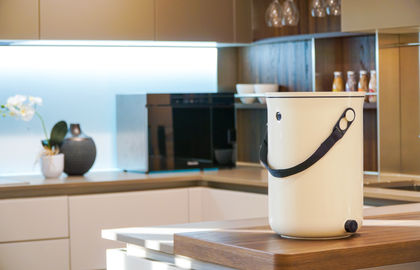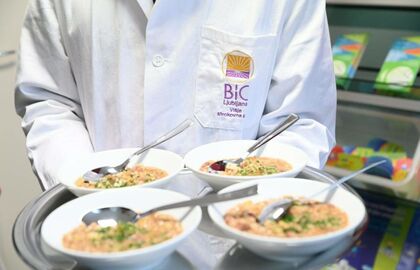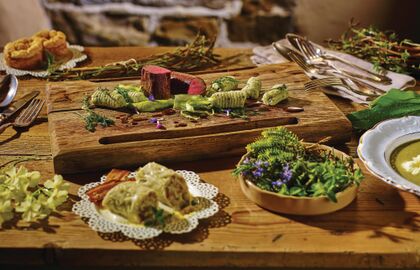The local cuisine with its international-award-winning chefs and restaurants has become one of Slovenia’s main tourist attractions: in 2021 Slovenia was the European Region of Gastronomy. The basis for the country’s cuisine is the top-quality local production of foods and beverages. “Slovenia is a unique destination with exceptional natural features and a strong sustainable commitment allowing the production of the highest quality ingredients”, wrote the Michelin guide a few years back. Food and beverage production mostly relies on small-scale farming which often uses organic methods. Emphasis is increasingly being put on health, safety, and sustainability.
The drive to sustainability and health is backed by strict regulations and quality control across the entire food production chain. This applies to all areas – yet regulation is particularly stringent in honey production, where Slovenia is the global leader in expertise and quality. Other important areas of Slovenia’s food and beverages industry (including close to 2,000 agricultural and fishing companies) are bakery products, meat products, dairies, fruit and fruit products, ice cream, non-alcoholic beverages, and beer. And lastly: wine. Slovenia benefits from excellent natural conditions for wine growing and produces top-class wines.
Small farms, often scattered throughout the mountainous regions of Slovenia, are not suitable for industrial-scale intensive agriculture: due to the unspoiled nature, they are ideal for organic, sustainable farming. Many winegrowers have also switched to biodynamic principles. Not only farms, but food production in general, is becoming increasingly focused on sustainable methods and the production of healthy food. One example: a coalition of beverage and food producers have accepted a self-regulation act to limit the sugar content in non-alcoholic beverages and some bakery and dairy products. All these moves towards health and sustainability are not coincidental: local consumers are very demanding because many still clearly remember the taste of homemade, home-grown food.
One of the top exporting Slovenian food products is ice cream. Many times awarded and praised for their innovativeness, Slovenian ice cream makers export literally hundreds of original ice cream products. A Slovenian company is the world’s largest pâté manufacturer – its products are sold in Europe, the USA, Russia, and the Middle East. Slovenia’s poultry farms have managed to increase the Omega-3 and selenium content in table eggs and meat through an innovative and sustainable method based on carefully devised feeding. Slovenian milk and dairy products are of top quality as they mostly come from small farms in the mountains.
Another branch that combines longstanding tradition with modern production methods is baking. The top bakery companies concentrate on healthy varieties of bread and milled products, like flakes, pasta, and porridge. The most famous Slovenian pastry product is without a doubt potica, a rolled pastry with different fillings (most often walnut). Fruit growers from Slovenia used to supply royal courts and export top-quality fruit to many countries in Europe and elsewhere. Again, traditional fruit growing is being enhanced with modern methods with an emphasis on quality over quantity – a typical trait of Slovenia’s food and beverages production.
To say that Slovenian honey is among the best in the world is no exaggeration. Three reasons: tradition, a high level of expertise, and rigorous rules that maintain the highest standards in beekeeping. The world’s second most popular bee subspecies among beekeepers is the Carniolan honeybee native to Slovenia.
Slovenian wines are not as well known to the public as those from France or Italy for example. Yet they are enjoying a growing reputation among wine connoisseurs, sommeliers, and restaurateurs all over the globe. The Gault and Millau International restaurant guide puts them “among the best wines of the world”. Several Slovenian wines win Decanter’s World’s Best Wines platinum and gold awards every year.
The basis of Slovenian boutique-oriented wine-growing is excellent climatic and soil conditions. Slovenia shares the same climatic belt with the Bordeaux region in France. Goriška Brda, for example, is grown under the same conditions as the much more well-known Collio from Italy – it is in fact the same region, only divided by a state border. A unique element of Slovenian wine growing, however, is a wide variety of microclimates condensed in a relatively small area. The main sorts grown in the western part of Slovenia include Chardonnay, Pinots, Sauvignon, Rebula (Ribolla Gialla), Cabernet, Merlot, and some exclusive sorts like Zelen, Pinela, or Teran. The Eastern part (Podravje region) is home to mostly white wines like Rieslings, Silvaner, Yellow Muscat, or Muscat Ottonel. Southeastern Slovenia is home to Cviček, a special light wine composed of a variety of white and red grape sorts.
The world’s most famous sausage is arguably Krainer Wurst - Carniolan sausage, in North America often simply called kielbasa (Slovenian word for the sausage is klobasa). It is named after Carniola, a dutchy in the ex-Hapsburg empire which now forms a central part of Slovenia. Carniolan sausage is now one of the food products with a European protected geographical indication.
Other food products with a protected origin include Slovenian honey, Piran’s salt, extra virgin olive oil from Slovenian Istria, pumpkin seed oil from Slovenian Styria and Prekmurje, a variety of cheeses (Nanos, Tolminc, Bovec, and Mohant), and dried meat products like Karst prosciutto, Prleška tünka, or Prekmurje ham.











